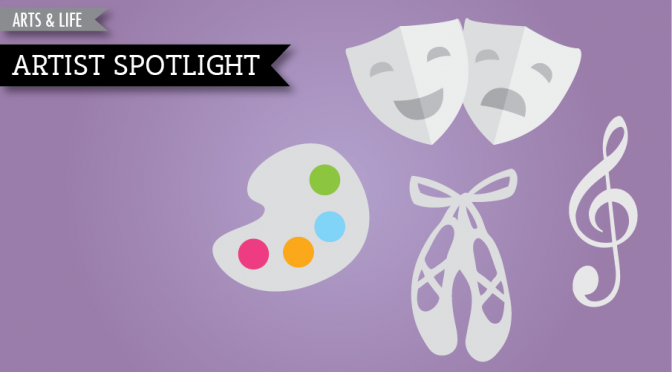
Many mediums, one artist
By: Annie Sragner, Arts & Life Editor
When sophomore Cadence Musick first began taking classes at Towson last year, she switched from studying graphic design to illustration before she finally found her passion in the painting, drawing and printmaking concentration.
“I had this realization that I really enjoy painting, and I think I was afraid to have that be my major,” Musick said. “So, it wasn’t until this semester that I changed to painting and decided that I wanted a career in art. I wanted to be an artist.”
Part of Musick’s interest in this creative field is the evolving definition of what it means to be a modern artist.
“It’s interesting because now artists are less idolized in a lot of ways and it makes art more universal, but there is a lot of blurring between an artist and someone that is really good at computer programming,” Musick said. “I like the fact that art is so much more of the people who never thought that they could do art and can now. We have the opportunity to go into these institutions and learn ways that we can make art fit into our lifestyle without it having to be this grand thing.”
Screen printing first got Musick’s attention when she would see the prints her friends were producing, but she found her passion for the art once she enrolled in the Screen Process I class.
“I really liked that class a lot, because it opened a lot of doors for me. That class is really what made me kind of see and explore what I want to do and the type of art I want to be making,” Musick said. “It’s cool because it’s a traditional medium, but there are so many new things going along with it.”
Since starting the class, Musick has experimented with her art by incorporating sound into her inspiration where she lets different sounds guide her work. For her most recent installation, called “A God,” she used a recording of different students reading a selected quote from the book “The Fountainhead.”
“I’ve always been interested in language and symbolism and how symbols are language,” Musick said. “It’s just a visual aspect of language combining those things together. I’m starting to fuse these concepts that I’ve been obsessed with and I’m slowly starting to learn how to fuse them together in my art in a way that makes sense.”
With the pressure of making a career out of art, Musick has tried to separate commercialism from her inspiration to create.
“I think that if you go into creating art with the mindset that you want to sell it, then you have already created a disconnect with yourself and the art you’re creating,” Musick said. “It’s not going to be as raw or truthful at the end of it. I think it’s definitely important to go in to make it because you have to or need to, not because there’s going to be a price tag on it at the end.”
Musick focuses more on the meaning of her work and would like to use her creations to promote social change and awareness. She is interested in curation and working with artists directly to create a collectivism that unites and inspires artists to see the power of their work.
“I want to start a conversation for sure,” Musick said. “I think one of the most beautiful things about art is how it gets people to feel uncomfortable, to think and to talk about things that aren’t being talked about.”
To further develop the expression of her art, Musick is working to enhance her creative skills in a wide range of artistic processes.
“What’s nice about drawing, printmaking and painting is that I can take all of these different classes because I want to fuse it all together,” Musick said. “I want to start focusing on making multiple media pieces and installation art where it encapsulates you.”
Musick finds the most satisfaction in her work through the hands-on nature that connects her to her medium.
“I’m so involved in the artwork, every part of it is a part of me,” Musick said. “It is an extension of me and I am an extension of the medium that I’m working with because there really is no disconnect there. It sinks into your pores.”

